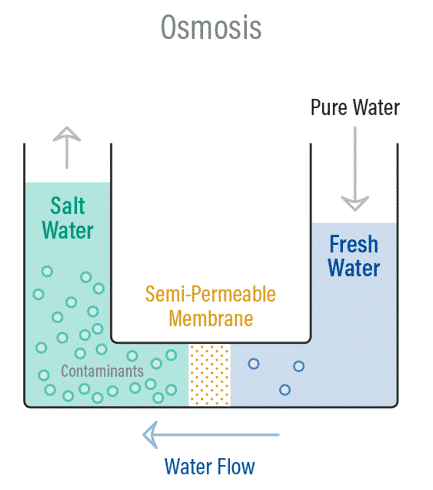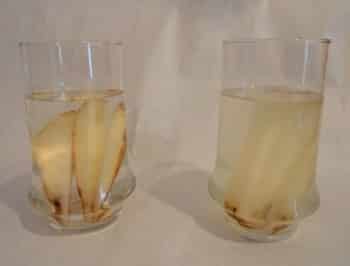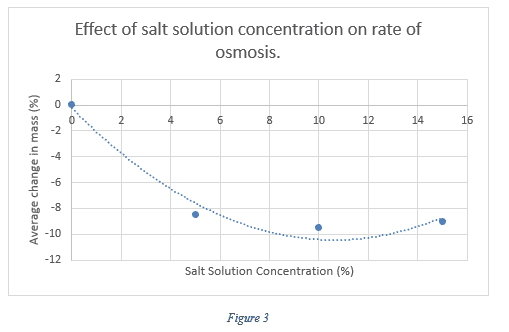INTRODUCTION
The cell membrane surrounds the cell and is responsible for regulating substances within the cell. There are many processes in which substances can travel through the membrane, one being osmosis.
Osmosis is a form of passive transport (no energy required) and is a type of diffusion in liquid substances. It is the transport of water molecules through the semipermeable section of the membrane from areas of low to high solute concentration (Figure One). Osmosis helps provide support in a plant cell. Furthermore, osmosis ensures the balance of liquid levels so that the cell doesn’t burst or shrivel. Water is attracted to the salt in cells and travels to where there is more salt to balance the levels. Therefore, the three states of an environment (hypertonic, hypotonic, and isotonic) determine the movement of water across the membrane.
For instance, if the water inside the cell is hypotonic compared to the extracellular environment, then water will travel into the cell by osmosis. When the water inside the cell is hypertonic compared to the extracellular environment, water travels out through osmosis. If both areas are isotonic, then both solutions will continue to remain balanced.

Figure 1
Potato Osmosis Lab Report
Why Does Potato Shrink in Salt Water?
AIM
To determine the effect of salt concentration has on the rate of osmosis.
HYPOTHESIS
If the salt solution concentration is increased, then the potato will experience a larger decrease in mass due to the occurrence of osmosis.
VARIABLES
Independent Variable: The three NaCl solutions (5%, 10%, and 15%) and the distilled water (containing 0% salt).
Dependent Variable: The rate of osmosis measured by the average percentage change in mass.
| Controlled Variable | Why | How |
| Duration of potatoes in salt solutions. | If the timing was inconsistent then results would become unreliable and incomparable due to the false results. If some potatoes were left in the solution for longer then more osmosis would occur and if potatoes were left for a shorter time, less osmosis would occur. | The timing of potatoes in the salt solution can be kept consistent with the use of a stopwatch and leaving the potato cubes in the solution for only 20 minutes. |
| Size | The dimensions and mass had to be consistent among all potatoes or the SA: Vol ratio would be different resulting in faster rates of osmosis, providing inaccurate data. | The dimensions and mass were kept similar by using a ruler to adjust the dimensions of the potato cubes and weighing them all to ensure a similar mass. |
| Volume of solution | If the volume of salt solution is different in the four beakers, then there will be more/less water to transport by osmosis. The potatoes would then gain/lose mass creating a random error and resulting in data that differs from the true answer. | The volume of salt solution can be controlled by using a measuring cylinder to maintain accurate results. The solution should be measured on a stable, flat bench. |
| Type of potato | If the potatoes are different types, then the salt will be varied in the potatoes. If the salt level is different then it will affect the rate of osmosis creating a random error in the data. | The same variety of potatoes should be used for all testing to have the same salt level, keeping the data consistent. |
EQUIPMENT
- 2 potatoes
- Knife
- Peeler
- Ruler
- 4 x 250 ml beakers
- Measuring Cylinder
- Electronic scales
- Paper towel
- Spoon
- 50 ml distilled water
- 50 ml 5%, 10%, 15% NaCl
Solution
METHOD

- Peel the potato.
- Accurately cut 4 cubes of potato that measure 2 x 2 x 2cm.
- Weigh all potato cubes individually and record data.
- Place 50 ml distilled water in a beaker.
- Place the 2 potato cubes in the distilled water.
- Leave for 20 minutes.
- Use a spoon to carefully remove the 2 potato cubes from the beaker and place them on a piece of paper towel to remove excess water.
- Record any visual observations in your table.
- Weigh the cubes and record.
- Calculate the change in mass.
- Calculate the % loss or gain in mass and record it in the table.
- Place the potato cubes in the container for disposal.
- Repeat steps 3 to 12 for 5%, 10%, 15% salt solution with a five-minute delay in-between each solution.
SAFETY AUDIT
| Hazards | Preventing Precaution |
| Knife and Peeler | The use of knives and peelers should be taken proceeded with caution. Full attention should be given to dealing with the sharp object and should be faced away from the user. When transporting sharp objects, they should be held by the user’s side with the blade facing down to prevent any occurring incidents. |
| Salt Solution | If the salt solution was to be spilt, it could cause people to fall over. Due to the heaviness of the salt solution bottles, the user should make sure to pour on a stable bench and maintain a good grip on the container. If any substances are spilt the user should alert surrounding people and clean the spill up before continuing the practice. |
| Glassware (Beakers) | To prevent breakage and having sharp glass the user should take caution when transporting glassware. Glass should be used on a stable bench to prevent it from falling. |
The predicted risk level of the practical ‘Effect of salt concentration on Osmosis in Potato Cells’ is low.
RESULTS
RECORDING OF CHANGE IN POTATO CUBES:
| Salt Solution Concentration (%) | Cube No. | Initial Mass (g) | Final Mass (g) | Change in Mass (g) | Change (%) | Average (%) |
| 0 | 1 | 10.5 | 10.6 | .1 | .1 | .05 |
| 2 | 9.2 | 9.2 | 0 | 0 | ||
| 5 | 3 | 8.9 | 8.1 | – .8 | -9 | -8.5 |
| 4 | 8.5 | 7.8 | – .7 | -8 | ||
| 10 | 5 | 9.4 | 8.5 | – .9 | -10 | -9.5 |
| 6 | 8.5 | 7.7 | – .8 | -9 | ||
| 15 | 7 | 10.6 | 9.6 | -1 | -9 | -9 |
| 8 | 10.6 | 9.6 | -1 | -9 |
Figure 2
Observations: The texture of the potato became spongier after the occurrence of osmosis. Water became slightly cloudy and starchier.


DISCUSSION
The overall trend showed the salt solution with higher concentration to experience a greater rate of osmosis resulting in a larger decrease in mass apart from the end of the individual graph, which would suggest a random error to have taken place. Both sets of osmosis potato experiment salt solution results data showed solutions with higher concentration is hypertonic compared to the potato cells meaning the water would travel to the solution because it contained more salt.
Evidently, the rate of osmosis in solutions with less salt was of a lesser extent because the water from the potato cells was less attracted. The distilled water was hypotonic compared to the potato cells that contain approximately 2% salt. Hence why both the individual and class data indicated a gain in the potato mass. These results were represented in the negative linear trend in the graph (Figure Three). The osmosis practical posed no situation where the potato cell and solution were in an isotonic state; however, it could be predicted that no overall net movement would occur, and the potato mass would stay the same.
EVALUATION
It is important to keep all controlled variables the same across all salt solutions to produce accurate data. If variables differ among the solutions then results would be influenced, producing inaccurate data. Various errors can be encountered in a practical way that can influence results, making them differ from the true answer.
The specific error encountered cannot be determined by the graph however the scatter and/or translation of data from the line of best fit can determine that there are errors involved. There were 10 sets of data undertaken that were all similar, comparing the individual data with the line of best fit from the class data (Figure Five) can show where random errors may have occurred.
If the entire set of data was to be moved but have a similar shape in the line of best fit, then it could be determined that a systematic error was of occurrence. The presence of random errors can be seen in the scatter graph (Figure Five), with the data from the 5% solution varying greatly and having an outlier.
A random error met was the slight difference in the size of potato cubes. A human cannot cut all potato cubes with precision, having the same weight and dimensions across all cubes. Although only a slight difference occurred with cubes ranging from 8.5 to 10.6 grams, smaller cubes would have a more efficient rate of osmosis due to their greater SA: Vol ratio and they would have a larger decrease in mass. This could be improved by using technology that can be relied on to cut all cubes with precision.
The accuracy of a human starting the stopwatch at the exact time the potatoes were submerged is unreliable because of their reaction time. The inaccuracy of time can result in some cubes being submerged in the solution for longer and allows time for more osmosis to occur, meaning the mass will be invalid.
For accurate timing, technology could be used to start and end exactly when the cubes are submerged and taken out. Another random error present was the excess water removed after the occurrence of osmosis. Drying the cubes with a paper towel could not be the same across all cubes and could remove different amounts of water from each cube.
This would change the mass because the cubes with less water soaked up, would have a heavier mass.
The systematic errors encountered in the practical included the calibration of equipment such as the stopwatch under the assumption that it was already working, causing invalid data.
Assumptions can also become a cause of a systematic error, an example being the assumption of the salt concentration in the solution as it was not tested prior to the practical and could result in consistently high/low results. Environmental effects such as the temperature of the lab, the potato cell concentration, and the potato age are systematic errors that can be present in the practical.
CONCLUSION
It was determined by testing potato cubes in salt solutions with different concentrations, that when the salt solution concentration was increased, the potato experienced a larger decrease in mass due to the occurrence of osmosis. This was evident from the results of the potato osmosis experiment lab report. The hypothesis for the potato in salt water experiment was supported by the individual data (Figure Two) and where errors occurred, the true value was supported by the class data.
Some limitations in the experiment were present such as the limited equipment such as technology that could have improved the precision, resulting in inaccurate data, and the inability to repeat the experiment, lowering the validity and reliability of the data gained. This conclusion aligns with typical potato osmosis experiment conclusions.
BIBLIOGRAPHY
Osmosis – an overview | ScienceDirect Topics (2020). Available at: https://www.sciencedirect.com/topics/neuroscience/osmosis (Accessed: 18 March 2020).
Diffusion and Osmosis – Difference and Comparison | Diffen (2020). Available at: https://www.diffen.com/difference/Diffusion_vs_Osmosis (Accessed: 23 March 2020).
Tonicity: hypertonic, isotonic & hypotonic solutions (article) | Khan Academy (2020). Available at: https://www.khanacademy.org/science/biology/membranes-and-transport/diffusion-and-osmosis/a/osmosis (Accessed: 23 March 2020).
(2020) Colby.edu. Available at: http://www.colby.edu/chemistry/CH142/lab/ErrorAnalysisExample.pdf (Accessed: 27 March 2020).
APPENDIX
| Group | 1 | 2 | 4 | 5 | 6 | 7 | 8 | 9 | 10 | Average |
| Salt Concentration % | ||||||||||
| 0 | 1.44 | 2.32 | 1 | 0 | 1.3 | 1.64 | 3.1 | 0 | 0.05 | 1.205556 |
| 5 | -5.55 | -5.63 | -8 | -4.02 | -5.9 | -4.33 | 3.9 | -5.5 | -8.5 | -4.83667 |
| 10 | -6.96 | -7.25 | -7 | -9.7 | -7.1 | -5.99 | -6.2 | -8.3 | -9.5 | -7.55556 |
| 15 | -10.83 | -9.23 | -8.5 | -6.58 | -8.4 | -7.15 | -6.6 | -8.85 | -9 | -8.34889 |
Figure 5, Class Data (Taken away group 3, inaccurate data)
[1] Tonicity: hypertonic, isotonic & hypotonic solutions (article) | Khan Academy (2020). Available at: https://www.khanacademy.org/science/biology/membranes-and-transport/diffusion-and-osmosis/a/osmosis (Accessed: 23 March 2020).

This has helped me with my osmosis egg lab assignment, thank you so much
when was this published?
probably 23 march 2020 since that is when they made their bibliography (cited sources)
thank you so much for this, I had a lab report due today on this topic, and it really helped me out!
Thank you!
This was very neat and important information